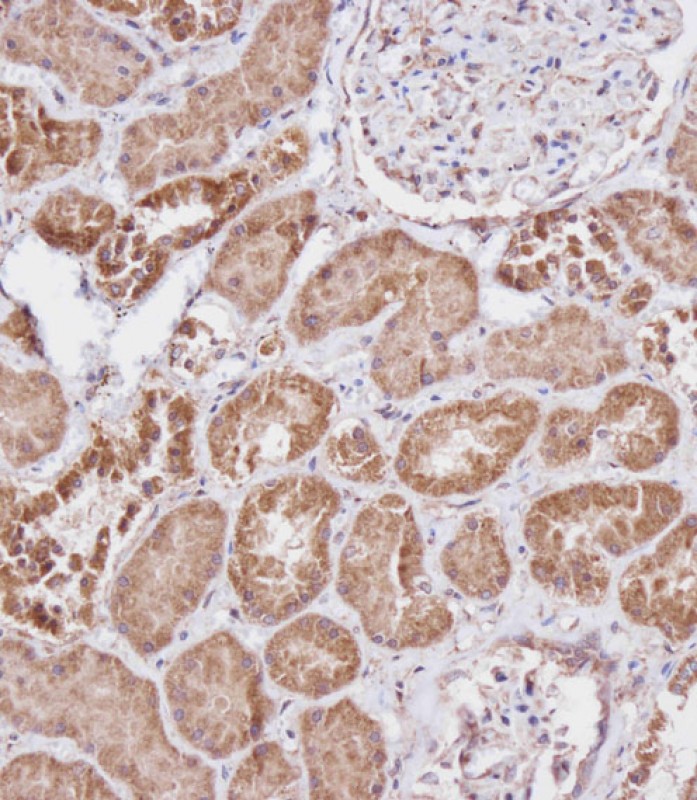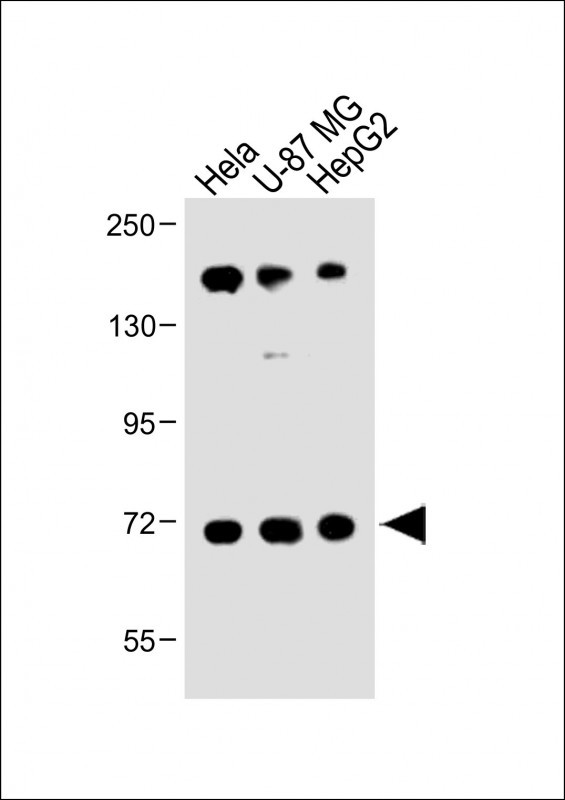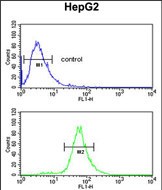FBXL5 Antibody (N-term)
Affinity Purified Rabbit Polyclonal Antibody (Pab)
- 产品详情
- 实验流程
Application
| IHC-P, FC, WB, E |
|---|---|
| Primary Accession | Q9UKA1 |
| Other Accession | Q8C2S5, A2VE78 |
| Reactivity | Human, Rat, Mouse |
| Predicted | Bovine |
| Host | Rabbit |
| Clonality | Polyclonal |
| Isotype | Rabbit IgG |
| Calculated MW | 78555 Da |
| Antigen Region | 86-115 aa |
| Gene ID | 26234 |
|---|---|
| Other Names | F-box/LRR-repeat protein 5, F-box and leucine-rich repeat protein 5, F-box protein FBL4/FBL5, p45SKP2-like protein, FBXL5, FBL4, FBL5, FLR1 |
| Target/Specificity | This FBXL5 antibody is generated from rabbits immunized with a KLH conjugated synthetic peptide between 86-115 amino acids from the N-terminal region of human FBXL5. |
| Dilution | IHC-P~~1:100 FC~~1:10~50 WB~~1:1000 E~~Use at an assay dependent concentration. |
| Format | Purified polyclonal antibody supplied in PBS with 0.09% (W/V) sodium azide. This antibody is purified through a protein A column, followed by peptide affinity purification. |
| Storage | Maintain refrigerated at 2-8°C for up to 2 weeks. For long term storage store at -20°C in small aliquots to prevent freeze-thaw cycles. |
| Precautions | FBXL5 Antibody (N-term) is for research use only and not for use in diagnostic or therapeutic procedures. |
| Name | FBXL5 |
|---|---|
| Synonyms | FBL4, FBL5, FLR1 |
| Function | Component of some SCF (SKP1-cullin-F-box) protein ligase complex that plays a central role in iron homeostasis by promoting the ubiquitination and subsequent degradation of IREB2/IRP2 (PubMed:19762596, PubMed:19762597). The C-terminal domain of FBXL5 contains a redox-sensitive [2Fe-2S] cluster that, upon oxidation, promotes binding to IRP2 to effect its oxygen-dependent degradation (PubMed:32126207). Under iron deficiency conditions, the N-terminal hemerythrin-like (Hr) region, which contains a diiron metal center, cannot bind iron and undergoes conformational changes that destabilize the FBXL5 protein and cause its ubiquitination and degradation (PubMed:19762596, PubMed:19762597). When intracellular iron levels start rising, the Hr region is stabilized (PubMed:19762596, PubMed:19762597). Additional increases in iron levels facilitate the assembly and incorporation of a redox active [2Fe-2S] cluster in the C- terminal domain (PubMed:32126207). Only when oxygen level is high enough to maintain the cluster in its oxidized state can FBXL5 recruit IRP2 as a substrate for polyubiquination and degradation (PubMed:32126207). Promotes ubiquitination and subsequent degradation of the dynactin complex component DCTN1 (PubMed:17532294). Within the nucleus, promotes the ubiquitination of SNAI1; preventing its interaction with DNA and promoting its degradation (PubMed:24157836). Negatively regulates DNA damage response by mediating the ubiquitin- proteasome degradation of the DNA repair protein NABP2 (PubMed:25249620). |
| Cellular Location | Cytoplasm, perinuclear region. Nucleus |
Research Areas
For Research Use Only. Not For Use In Diagnostic Procedures.
Application Protocols
Provided below are standard protocols that you may find useful for product applications.
REFERENCES
Salahudeen, A.A., et al. Science 326(5953):722-726(2009)
Vashisht, A.A., et al. Science 326(5953):718-721(2009)
Zhang, N., et al. Biochem. Biophys. Res. Commun. 359(1):34-39(2007)
Ilyin, G.P., et al. Genomics 67(1):40-47(2000)
Winston, J.T., et al. Curr. Biol. 9(20):1180-1182(1999)
Cenciarelli, C., et al. Curr. Biol. 9(20):1177-1179(1999)
终于等到您。ABCEPTA(百远生物)抗体产品。
点击下方“我要评价 ”按钮提交您的反馈信息,您的反馈和评价是我们最宝贵的财富之一,
我们将在1-3个工作日内处理您的反馈信息。
如有疑问,联系:0512-88856768 tech-china@abcepta.com.
¥ 1,250.00
Cat# AP9409a























 癌症的基本特征包括细胞增殖、血管生成、迁移、凋亡逃避机制和细胞永生等。找到癌症发生过程中这些通路的关键标记物和对应的抗体用于检测至关重要。
癌症的基本特征包括细胞增殖、血管生成、迁移、凋亡逃避机制和细胞永生等。找到癌症发生过程中这些通路的关键标记物和对应的抗体用于检测至关重要。 为您推荐一个泛素化位点预测神器——泛素化分析工具,可以为您的蛋白的泛素化位点作出预测和评分。
为您推荐一个泛素化位点预测神器——泛素化分析工具,可以为您的蛋白的泛素化位点作出预测和评分。 细胞自噬受体图形绘图工具为你的蛋白的细胞受体结合位点作出预测和评分,识别结合到自噬通路中的蛋白是非常重要的,便于让我们理解自噬在正常生理、病理过程中的作用,如发育、细胞分化、神经退化性疾病、压力条件下、感染和癌症。
细胞自噬受体图形绘图工具为你的蛋白的细胞受体结合位点作出预测和评分,识别结合到自噬通路中的蛋白是非常重要的,便于让我们理解自噬在正常生理、病理过程中的作用,如发育、细胞分化、神经退化性疾病、压力条件下、感染和癌症。








